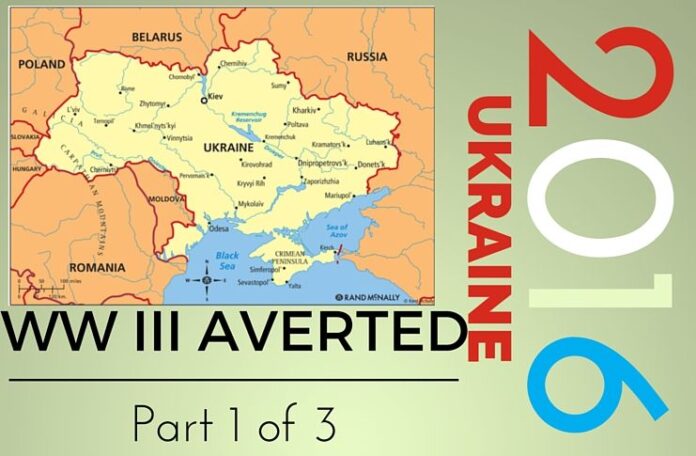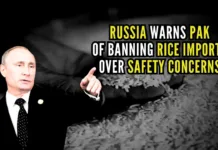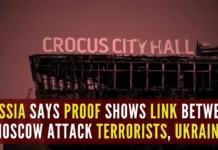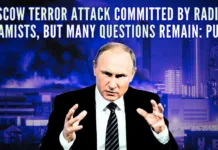
How tension in Ukraine was diffused
[dropcap color=”#008040″ boxed=”yes” boxed_radius=”8px” class=”” id=””]F[/dropcap]rom 2014 to 2015 events were trending towards a major world war. Ukraine president talked of launching a World War against Russia. Russia landed in the Eastern part and launched a proxy occupation on behalf of the Russians there. Israel and U.S. Assistant Secretary of State for European and Eurasian Affairs Victoria Nuland, on behalf of Ukraine, launched the Maidan revolution and President Yanukovych was overthrown. The West was also involved in Syria where they wanted to overthrow President Assad in order to make Israel safe. Under the threat of increasing sanctions, Iran was under pressure to sign the Non-Proliferation Agreement with the US. Consequently, the whole belt stretching from the USSR through Ukraine to Syria, Israel and Iran was a political rift separating the West from the rest. Besides this cultural rift, North Korea and the South China Sea are major areas of global conflict, which could lead to World War III.
From March 3, 2016, Ukraine’s bellicosity began to change. European Commission President Jean-Claude Juncker diffused global tensions with one sentence, “Ukraine is not likely to join the EU and NATO for 20 to 25 years.” No reason was given but French President François Hollande provided one, Russian objections. Juncker’s declaration was echoed by NATO’s Secretary General Jens Stoltenberg who said that Ukraine is not ready to join NATO. NATO did, however, have a 2016 Cooperation Plan to update Ukraine’s military to NATO’s standards, including bringing the military under civilian control.1 The EU boosted Ukraine with an aid package of $40 billion for modernization of its economy.
[dropcap color=”#008040″ boxed=”yes” boxed_radius=”8px” class=”” id=””]T[/dropcap]he Juncker-Stoltenberg declarations gave Russia an opportunity to relax a bit since it was on a war footing; Europe showed that it was not going to make Ukraine a major issue for the twenty-first century.2 Nor was Europe and the US going to be goaded into a world war by any bellicose ethic group. The emphasis was going to be on East Asia. Whereas Ukraine, with Georgia, had the backing of President George W. Bush to join NATO, these declarations showed that NATO would not follow Bush’s policy in the near future. Bush’s aggressive policy was countered by Russia defending Russians living abroad, in this case, Eastern Ukraine.
Europe saved itself from nuclear damage by these Juncker-Stoltenberg declarations. In Syria, Russia was engaged in a conventional war, but against the EU the confrontation would be full blown, using all the weapons available. Russia was never threatened militarily by bankrupt Ukraine’s strength.
In fact, Russia treated Ukraine like a family member. It’s boundaries, for example, were expanded by courtesy of Russia: in 1654 it was a small unit; from 1654 to 1917, Russia’s tsars annexed the north to Ukraine, from Poltava to the Lviv border; in 1939 and 1945 Stalin gave the west, with Lviv as the major centre, to it; in 1922, the south, from Lugansk to Odessa, was added by Vladimir Lenin; and, in 1954, Nikita Khrushchev gave it, which was part of the Soviet Union, the Crimean Oblast. In addition, in 1991, when the Soviet Union imploded, Ukraine inherited 5,000 nuclear bombs, which made it the third largest nuclear power in the world.3 Besides, it has a thousand year history that unites it with Russia on the basis of historical and cultural ties; its second language is Russian.4
[dropcap color=”#008040″ boxed=”yes” boxed_radius=”8px” class=”” id=””]D[/dropcap]espite its close links with Russia, Ukrainian President Petro Poroshenko sought consistently to be free from Russian domination.5 Poroshenko had good reasons to pursue this course. Western values are better than Communist in that the former advocates freedom of the individual and human rights, to mention a few characteristics.
By the Budapest Memorandum signed by Britain, US, Russia and Ukraine in 1994, Ukraine agreed to get rid of all Soviet weapons on its territory, send the nuclear weapons to Russia, and sign the Non-Proliferation Treaty. The US Secretary of State James Baker pushed for this Agreement because he did not want to see an unravelled Soviet Union be a “Yugoslavia with nukes.” In return, the signatories agreed to treat Ukraine as an independent, sovereign state, with territorial integrity and non-intervention as guiding principles. It was also understood that the freedoms expressed in the 1975 Helsinki Accords and signed mainly by 35 European nations would apply to Ukraine.6 Unfortunately, Ukraine was disarmed but its independence was not guaranteed.
Almost the whole of 2014 and 2015 were years of conflict for Ukraine. In the words of Secretary of Ukraine’s National Security and Defence Council Oleksander Turchynov the Budapest Memorandum was just a formal document without tools to fulfill guarantees.7 But, according to President Obama, Ukraine will always be vulnerable to Russian domination so that reliance has to be placed on the Organisation for Security and Cooperation in Europe (OSCE) and the UN. To a certain extent, Poroshenko is right in that he tried to use all legal and diplomatic means to maintain Ukraine’s independence and secure its borders.
To be continued…
Bibliography
-
“NATO Secretary General discusses key defense reforms with Ukraine Minister of Defense,” nato.int, March 8, 2016. See also, “Juncker says Ukraine not likely to join EU, NATO for 20-25 years,” rferl.org, March 4, 2016.
-
Paul Saunders, “How Russia sees Ukraine crisis,” nationalinterest.org, October 13, 2014.
-
org.
-
Mathew Dal Santo, “Russia and Ukraine’s Medieval Love Affair,”nationalinterest.org, March 11, 2015.
-
“Ukrainians will die and shed blood to be in the same deep water with Europe,” pravda.ru, March 1, 2016.
-
Ron Synovitz, “Explainer: The Budapest Memorandum and its relevance to Crimea,” rferl.org, February 28, 2014.
-
“Top Ukrainian security official criticizes Budapest Memorandum,” usatoday.com, December 5, 2015.
- Part2 – China’s Road to Superpower status - July 20, 2017
- Part1 – China’s Road to Superpower status - July 18, 2017
- P2 – Can or should Qatar be ostracised? - June 29, 2017










